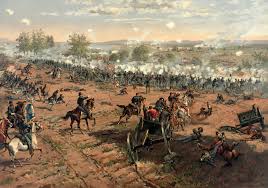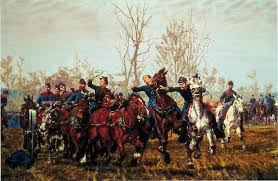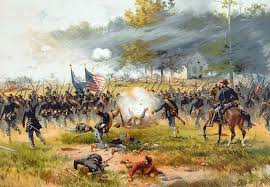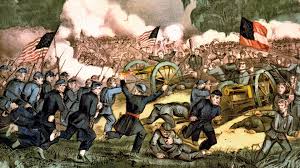What is the difference between a war and a battle?
A Brief Explanation of War and Battle

War and battle are two terms often used interchangeably, but they represent distinct concepts in the realm of conflict and warfare. At their core, both war and battle involve armed conflict between opposing forces, but they differ in terms of scope, objectives, and impact.
Understanding the difference between war and battle is crucial for grasping the complexities of military history and strategy. War: War is a large-scale conflict that typically involves entire nations or groups with differing political, economic, or social interests.
It is characterized by prolonged engagements aimed at achieving strategic goals such as territorial expansion, regime change, or ideological dominance. Wars can be fought on various fronts – from land to sea to air – and may have far-reaching consequences that extend beyond the battlefield.
Battle: On the other hand, a battle is a specific engagement within a larger war where armed forces directly confront each other in combat. Battles are tactical in nature, focusing on achieving victory in a particular location or time frame.
They are often decisive moments that can sway the course of a war but do not encompass the full scope of conflict seen in wars. Battles are essential components of warfare but represent only one aspect of the broader strategy involved in waging war.
Definition of War
Large-scale conflict between nations or groups
When we talk about war, we’re not just referring to a simple skirmish or a small scuffle. No, war is a full-blown clash between nations or groups that involves massive scale and intensity.
It’s like the ultimate showdown on the global stage, where countries pit their military might and resources against each other in a bid for dominance. Picture it as a high-stakes game of chess but played with tanks, planes, and soldiers instead of pieces on a board.
In a war, the stakes are incredibly high as entire populations can be affected by the outcomes. The conflicts can span across regions and even continents, with alliances forming and crumbling like sandcastles in the tide.
It’s not just about winning battles; it’s about shaping the course of history itself. The sheer magnitude of a war can be overwhelming to comprehend, but it’s essential to understand its gravity when discussing such monumental events in human history.
Involves political, economic, and social factors

War isn’t just about guns blazing and bombs dropping; it’s also intricately intertwined with complex political, economic, and social factors that shape its course. Political motivations often drive countries into conflict as leaders seek to assert power or pursue specific agendas on the global stage. Economic interests play a crucial role too, with resources, trade routes, and territories becoming hotly contested prizes in the midst of war.
Furthermore, wars have profound social implications as well. They can disrupt entire societies, displace populations, and sow seeds of division that can last for generations.
The human cost of war extends far beyond the battlefield – it seeps into every aspect of life for those caught in its grasp. Understanding these multifaceted dimensions is key to grasping the true nature of war and appreciating its far-reaching impact on our world.
Engaging in the Heat of Battle
When we delve into the intricacies of warfare, it is essential to understand the fundamental concept of a battle. A battle is not just a mere skirmish or clash between opposing forces; it is a crucial component within the broader context of war. In essence, battles serve as the frontline theaters where armed forces directly engage in combat, striving to outmaneuver and overpower their adversaries through strategic maneuvers and tactical prowess.
The Essence of Direct Combat
Direct combat lies at the heart of every battle, where soldiers face each other on the battlefield, armed with weapons and determination. It is here that courage and skill are put to the ultimate test as troops engage in life-and-death struggles to secure victory for their cause. The chaos and intensity of combat define the very essence of a battle, shaping its outcome through sheer willpower and resilience.

Navigating Through Adversity
In the heat of battle, soldiers must navigate through a maelstrom of gunfire, explosions, and chaos while adhering to their training and discipline. Each decision made on the battlefield can tip the scales towards success or failure, making split-second judgments critical for survival. The ebb and flow of combat create an atmosphere charged with adrenaline and tension, where bravery shines amidst adversity, forging bonds among comrades-in-arms that withstand the crucible of war.
Differences Between War and Battle
Scope:
In the vast landscape of conflict, the scope of war is like a sweeping saga that unfolds over time, encompassing multiple battles like chapters in a book. War is not a singular event but rather a series of engagements that shape the course of history.
Each battle within a war adds a layer to the narrative, leading to either victory or defeat for the warring parties. The scale and duration of war set it apart from individual battles, which are more focused and immediate in nature.
On the other hand, a battle is akin to a pivotal scene in a play, where characters clash in intense combat on a specific stage. Unlike war, which spans across years or even decades, battles are confined within shorter time frames and geographical locations.
A battle may decide the outcome of a particular confrontation but does not represent the entirety of the conflict. It is but one piece in the intricate puzzle that is war.
Objectives:
The objectives of war and battle differ significantly in terms of their goals and aspirations. War aspires towards achieving strategic aims that go beyond mere battlefield victories. It seeks to resolve underlying conflicts between nations or factions through political, economic, and social means.
War aims to establish dominance or secure peace through decisive action on various fronts. In contrast, battle zooms in on tactical victory within a limited context—a specific location or time frame where combatants engage directly with each other.
The primary objective of any battle is to emerge triumphant in that particular engagement by outmaneuvering or overpowering the enemy forces present on the battlefield. While battles contribute to the overall progress of war, their objectives are more immediate and tangible.
Participants:
War involves an extensive cast of characters—entire nations or factions mobilizing their resources, strategies, and populations towards achieving their respective goals. The participants in war operate at different levels ranging from political leaders making strategic decisions to civilians enduring hardships brought about by conflict.
The complexity of war arises from the multitude of players involved in shaping its outcome. Conversely, battles feature smaller units engaging directly on the front lines—soldiers facing each other in combat with clear objectives set for that specific engagement.
In battles, individual bravery and skill often come to the forefront as soldiers fight for supremacy over limited territory or resources. While wars may be waged by nations as entities, battles are fought by individuals embodying courage and determination amidst chaos.
Impact of War and Battle
War, as a large-scale conflict involving nations or groups, has profound and far-reaching consequences on societies, economies, and politics. The impact of war extends beyond the battlefield, affecting civilian populations, infrastructure, and governance structures. Societies are often torn apart by war, leading to displacement of civilians, destruction of homes and communities, and long-lasting trauma.
Economically, wars can devastate countries by depleting resources, disrupting trade networks, and causing inflation. Moreover, the political landscape can be reshaped by war through changes in leadership, alliances between nations, and the emergence of new power dynamics.
The Influence of Battle
On the other hand, battles play a crucial role in determining the outcome of a specific engagement within a larger conflict. These intense and focused military encounters have immediate impacts on the course of a war.
The outcome of battles can sway public opinion towards one side or another, boost morale within armed forces or demoralize them significantly. Winning a decisive battle can shift momentum in favor of one party while losing can lead to setbacks that require strategic reassessment.
Battles also have ripple effects beyond their immediate results. They can shape future tactics and strategies employed by both sides as lessons are learned from successes or failures on the battlefield.
Additionally, the casualties incurred during battles directly impact the strength and readiness of military forces involved in ongoing conflicts.
Examples of War and Battle
War: World War II, Cold War
World War II stands as one of the most devastating conflicts in human history. It involved major world powers such as the Allies (including the United States, United Kingdom, Soviet Union, and others) against the Axis powers (Germany, Italy, Japan). The war spanned from 1939 to 1945 and resulted in millions of casualties across various theaters of combat.
The strategic objectives of World War II included defeating fascism and securing peace through a new world order. The Cold War, on the other hand, was a period of geopolitical tension between the United States and its allies in NATO against the Soviet Union and its allies in the Warsaw Pact.
Lasting from the late 1940s to the early 1990s, this “war” was characterized by political maneuvering, espionage, propaganda wars, and proxy conflicts rather than direct military engagements. The Cold War had a global impact as both superpowers sought to expand their spheres of influence without engaging in open warfare.
Battle: D-Day, Battle of Gettysburg
D-Day refers to June 6, 1944 when Allied forces launched a massive amphibious invasion on the beaches of Normandy during World War II. This pivotal battle marked the beginning of the end for Nazi Germany’s control over Western Europe. With thousands of troops landing on five different beaches under heavy fire from German defenses, D-Day was a critical turning point that led to eventual Allied victory in Europe.
The Battle of Gettysburg took place over three days in July 1863 during the American Civil War. It was fought between Confederate General Robert E. Lee’s Army of Northern Virginia and Union General George G. Meade’s Army of the Potomac.
The battle resulted in high casualties on both sides but ended with a decisive Union victory that halted Lee’s invasion into Northern territory. Often considered a turning point in the Civil War, Gettysburg is remembered for its fierce fighting and strategic significance.
In Summation
Summarizing the Distinctions
It is evident that while war and battle are often used interchangeably in colloquial language, they represent distinct concepts in the realm of military strategy and conflict. War encompasses a broad spectrum of activities, involving multiple battles over an extended period, with far-reaching consequences that impact societies, economies, and political landscapes. On the other hand, a battle is a specific engagement within a war, focusing on achieving tactical victory in a particular location or timeframe.
Distinguishing Factors
One key difference lies in the scope of these terms. War involves entire nations or factions with diverse resources and strategies, whereas a battle typically involves smaller units engaging in combat on the front lines. Furthermore, the objectives of war are aimed at achieving strategic goals and resolving conflicts on a larger scale, while battles focus on gaining tactical advantages to influence the outcome of specific engagements within the overarching conflict.
A Positive Outlook
Understanding the disparities between war and battle can foster a deeper appreciation for the complexities of armed conflict throughout history and contemporary society. By grasping these distinctions, we can develop a clearer perspective on how military operations unfold and their impacts on global dynamics.
While war may symbolize destruction and chaos, battles represent moments of resilience and determination where individuals come together to confront challenges head-on. Ultimately, recognizing these differences allows us to acknowledge both the hardships endured during wartime and the courage displayed in individual acts of valor on the battlefield.

